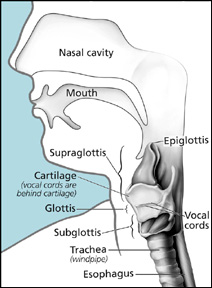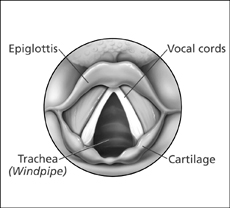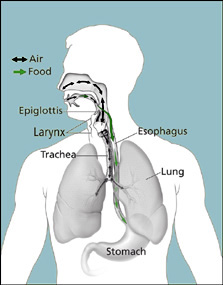|
The Larynx
The larynx is an organ
at the front of your neck. It is also
called the voice box. It is about 2
inches long and 2 inches wide. It is
above the windpipe (trachea).
Below and behind the larynx is the esophagus.
The larynx has two bands of muscle that form the
vocal cords.
The cartilage at the front of the
larynx is sometimes called the Adam’s apple.
The larynx has three main parts:
The top part of the larynx is the
supraglottis.
The glottis is in the middle. Your
vocal cords are in the glottis.
The subglottis is at the bottom.
The subglottis connects to the windpipe.
|

This picture shows the main parts of the larynx.
|
|

This picture shows how the larynx
looks from above. It is what the
doctor can see with a mirror.
|
The larynx plays a role in breathing, swallowing, and talking.
The larynx acts like a valve over the windpipe. The valve opens and closes to
allow breathing, swallowing, and speaking:
Breathing: When you breathe, the vocal cords relax and
open. When you hold your breath, the
vocal cords shut tightly.
Swallowing: The larynx protects the windpipe. When you swallow, a flap called the epiglottis covers the opening of
your larynx to keep food out of your lungs.
The food passes through the esophagus on its way from your mouth to your
stomach.
Talking: The larynx produces the sound of your
voice. When you talk, your vocal cords
tighten and move closer together. Air
from your lungs is forced between them and makes them vibrate. This makes the sound of your voice. Your tongue, lips, and teeth form this sound
into words.

This picture shows the larynx and
the normal pathways for air and food.
|
< Previous Section | Next Section > |